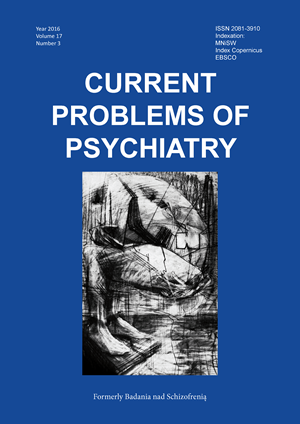Hyper-coherence and increased energy of gamma oscillations in patient with first onset schizophrenia and cerebral white matter damage
DOI:
https://doi.org/10.1515/cpp-2016-0015Słowa kluczowe:
schizofrenia, istota biała, matching pursuit, koherencjaAbstrakt
Wstęp: Zgodnie z obecną wiedzą częstotliwość gamma jest ściśle powiązana z działaniem sieci neuronowych leżących u podstaw podstawowej aktywności mózgu i umysłu. Zaburzenia mechanizmów synchronizacji aktywności mózgu obserwowane u pacjentów z rozpoznaniem schizofrenii, są podstawą zaburzeń neuropoznawczych i objawów psychopatologicznych choroby. Mechanizmy synchronizacją są także związane ze strukturą i efektywnością istoty białej mózgu. Dotąd przeprowadzono niewiele analiz zmian w obrazie wysokich częstotliwości, występujących u pacjentów ze schizofrenią i jednocześnie uszkodzeniami istoty białej. Celem pracy było zobrazowanie specyficznych cech fal gamma u osób z różnym rozpoznaniem psychiatrycznym i stanie struktury mózgu
Metody: Przeprowadzono analizę ilościową zapisu EEG zarejestrowanego dla pacjentki chorej na schizofrenię wraz ze stwierdzonym uszkodzeniem istoty białej mózgu (SCH+WM), pacjentki z tożsamym rozpoznaniem, ale bez zmian strukturalnych widocznych w MRI (SCH-WM) oraz osoby zdrowej (HC). Zakres fal gamma uzyskano przez zastosowanie filtrów analogowych, w celu szerszej analizy częstotliwości gamma podzielono na trzy pasma: 30-50Hz, 50-70Hz, 70-100Hz. Do analizy sygnału użyto algorytmu Matching Pursuit, dzięki któremu oceniono zmiany w energii sygnału. Do sprawdzenia efektywności synchronizacji poszczególnych obszarów mózgu użyto wskaźnika koherencji dla wybranych par elektrod.
Wyniki: Wyniki przeprowadzonych analiz wskazują, że w zapisie EEG pacjentki SCH+WM zidentyfikowano najwyższy poziom energii sygnału dla wszystkich analizowanych pasm w porównaniu do wyników uzyskanych dla tych samych par elektrod pozostałych dwóch osób. Wyniki koherencji wykazały hiperkompensacje u SCH+WM a jej poziom różnił się zasadniczo od wyników pozostałych osób.
Wnioski: Współwystępowanie schizofrenii i uszkodzeń istoty białej może istotnie zakłócać parametry aktywności neuronalnej o wysokich częstotliwościach. Poddano dyskusji propozycje wyjaśnieńBibliografia
1. Uhlhaas P. J., Singer W. Neural synchrony in brain disorders: relevance for cognitive dysfunctions and pathophysiology. Neuron, 2006; 52, 155–16810.
2. Jia X, Kohn A. Gamma Rhythms in the Brain. PLoS Biol, 2011; 9(4): e1001045.
3. Başar, E. Brain oscillations in neuropsychiatric disease. Dialogues in Clinical Neuroscience, 2013; 15(3), 291-300.
4. Cardin JA, Carlén M, Meletis K, Knoblich U, Zhang F, et al. Driving fast-spiking cells induces gamma rhythm and controls sensory responses. Nature. 2009; 459:663-67.
5. Hirano Y., Oribe N., Kanba S., Onitsuka T., Nestor, P. G., & Spencer, K. M. Spontaneous Gamma Activity in Schizophrenia. JAMA Psychiatry, 2015; 72(8), 813-821.
6. Messias, E., Chen, C.-Y., & Eaton, W. W. Epidemiology of Schizophrenia: Review of Findings and Myths. The Psychiatric Clinics of North America, 2007; 30(3), 323-338.
7. Jonathan K. Wynn, Gregory A. Light, Bruno Breitmeyer, Keith H. Nuechterlein, and Michael F. Green. Event-Related Gamma Activity in Schizophrenia Patients During a Visual Backward-Masking Task. American Journal of Psychiatry, 2005; 162(12), 2330-2336.
8. Wilson T.W., Hernandez O.O., Asherin R.M., et al. Cortical gamma generators suggest abnormal auditory circuitry in early-onset psychosis. Cereb Cortex, 2008; 18, 371-378.
9. Williams LM, Whitford TJ, Gordon E, et al. Neural synchrony in patients with a first episode of schizophrenia: tracking relations with grey matter and symptom profile. J Psychiatry Neuroscience, 2009; 34, 21-29.
10. Cho R.Y., Konecky R.O., Carter C.S. Impairments in frontal cortical gamma synchrony and cognitive control in schizophrenia. Proc Natl Acad Sci U.S.A. 2006; 103(198), 78–83.
11. Minzenberg M. J., Firl A. J., Yoon J. H., Gomes G. C., Reinking C., & Carter C. S. Gamma Oscillatory Power is Impaired During Cognitive Control Independent of Medication Status in First-Episode Schizophrenia. Neuropsychopharmacology, 2010; 35(13), 2590–2599.
12. Spencer K.M., Niznikiewicz M.A., Shenton M.E., et al. Sensory-evoked gamma oscillations in chronic schizophrenia. Biological Psychiatry, 2008;63:744–747.
13. Tikka S.K., Nizamie SH, Das B, Katshu MZ, Goyal N. Increased spontaneous gamma power and synchrony in schizophrenia patients having higher minor physical anomalies. Psychiatry Res. 2013; 207(3):164-72.
14. Mitra, S., Nizamie, S. H., Goyal, N. and Tikka S. K. Evaluation of resting state gamma power as a response marker in schizophrenia. Psychiatry Journal of Clinical Neuroscience, 2015; 69: 630-639.
15. Williams A. B.; Taylors F. J. Electronic Filter Design Handbook. New York McGraw-Hill 1988.
16. Kam J. W. Y., Bolbecker A. R., O’Donnell B. F., Hetrick W. P., Brenner C. A. Resting state EEG power and coherence abnormalities in bipolar disorder and schizophrenia. Journal of Psychiatric Research, 2013: 47(12), 1893-1901.
17. Stoica P., Moses R. Spectral Analysis of Signals. Upper Saddle River, NJ: Prentice Hall, 2005
18. Mallat S. G., Zhang Z. Matching Pursuit with time-frequency dictionaries. IEEE Transactions On Signal Processing,1993; 41(12), 3397-3415.
19. Franaszczuk P. J, Bergey G. K., Durka P. J., Eisenberg H. M. Time-frequency analysis using the matching pursuit algorithm to seizures originating from mesial temporal lobe. Electroencephalog-raphy and Clinical Neurophysiology, 1998; 106(6), 513-521.
20. Stuckey D.E., Lawson R., Luna L.E. EEG gamma coherence and other correlates of subjective reports during ayahuasca experiences. J Psychoactive Drugs.2005; 37(2):163-78.
21. Borjigin J., Lee U., Liu T., Pal D., Huff S., Klarr D., Mashour G. A. Surge of neurophysiological coherence and connectivity in the dying brain. Proceedings of the National Academy of Sciences of the United States of America, 2013; 110(35): 14432-14437.
22. Medvedev A. V., Murro A. M., Meador K. J. Abnormal interictal gamma activity may manifest a seizure onset zone in temporal lobe epilepsy. International Journal of Neural Systems, 2011; 21:02:103-114.
23. Buzsáki G, da Silva F.L. High frequency oscillations in the intact brain. Prog Neurobiol. 2012; 98:241-249.
24. Pajevic S., Basser P. J., & Fields R. D. Role of Myelin Plasticity in Oscillations and Synchrony of Neuronal Activity. Neuroscience, 2014; 276, 135–147.
25. Liu I., Dietz K., DeLoyht J. M., Pedre X., Kelkar D., Kaur I., et al. Impaired adult myelination in the prefrontal cortex of socially isolated mice. Nature Neuroscience, 2012; 15, 1621-1624.
Pobrania
Opublikowane
Numer
Dział
Licencja
Prawa autorskie (c) 2016 Autorzy

Praca jest udostępniana na licencji Creative Commons Attribution-NonCommercial-NoDerivatives 3.0 Unported License.


